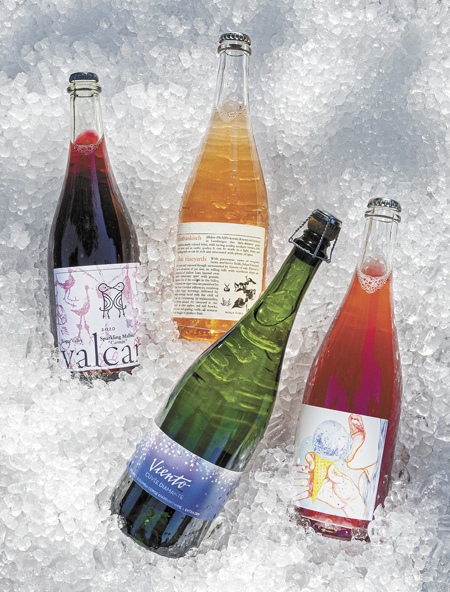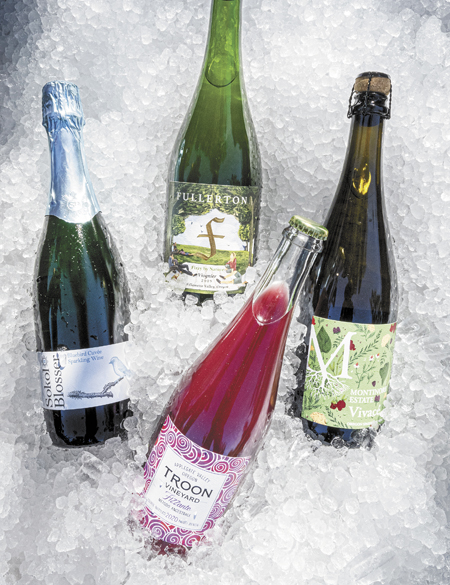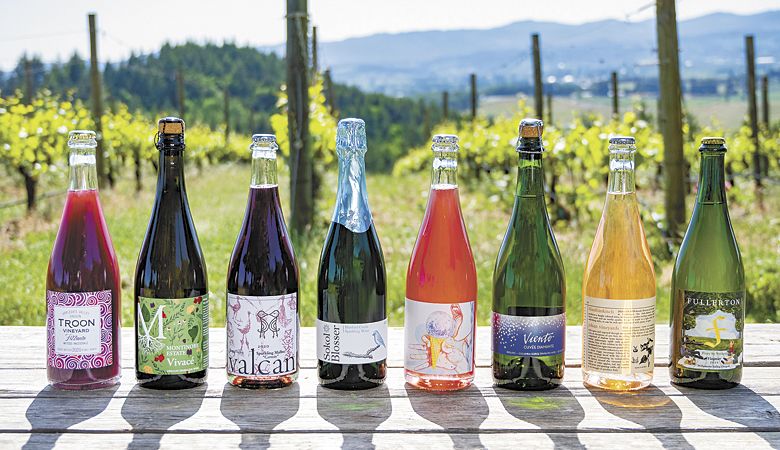Offbeat Bubbles
Uncorking Oregon’s unexpected
If you think Oregon wine revolves purely around prim Pinot Noir and straitlaced Chardonnay, guess again. The state’s winemakers may be all business up front, but there’s a party in the back, and it’s sparkling.
With an energy akin to France’s hip grower Champagne scene, Oregon’s booming bubbles business makes short work of la méthode Champenoise.
When Dom Pérignon allegedly proclaimed, “Come quickly, I’m drinking the stars!” he was referring to Champagne predominately made from Pinot Noir, Chardonnay and Pinot Meunier. According to wine expert Katherine Cole, author of “Sparkling Wine Anytime,” Pinot Noir and Chardonnay continue their sparkling supremacy as they both (more or less) “ripen in cooler climates and make flavorful, high-acid base wines.” She also explains how Pinot Noir and Pinot Meunier are low in pigment and full of aromatics, both attributes ideal for the finest bubbles.
However, in unfettered Oregon, more and more fizz makers opt for atypical varieties, creative blends and whimsical labels that shout “Celebrate!” Meet some of these renegade sparkling producers:

1. Valcan Cellars Carmin Sparkling Malbec, Rogue Valley
“When we came out with our white Malbec, I saw a need for new wines,” said J.P. Valot of Valcan Cellars in Corvallis. “After tasting some red sparkling wines that were a little sweet, I thought I could come out with a better option if I use Malbec.”
Valot named the wine “Carmin” in honor of his sister, Natalia’s, favorite color. The key to this brilliantly hued Malbec’s success can be found in the fruit’s maturity. He intentionally picks the grapes at a similar ripeness to that of traditional sparkling varieties Chardonnay and Pinot Noir.
“This is not a regular Malbec that I decided to make [into] sparkling,” Valot explained. “This is a wine that was thought and planned, since I envisioned a different kind of sparkling red.”
After seven days of carefully calibrated skin contact, Valot presses the juice, then ferments in tank for two weeks using native yeasts, followed by five months of sur lie (on the lees) aging. Jon Casteel of Casteel Bottling force-carbonates the wines before bottling; crown caps literally seal the deal.
“I think the wine is so special because you won’t find many sparkling red Malbecs around,” Valot exclaimed, “and it’s dry!”
2. Minimus Blaufränkisch Pét-Nat, Johan Vineyard, Van Duzer Corridor
“It was kind of a happy accident,” admitted Minimus winemaker Laura Cusick of Craft Wine Co. in Carlton. The non-vintage sparkling Blaufränkisch pét-nat (pétillant naturel) combines two-year aged 2018 rosé of Blaufränkisch — also known as Lemberger — with 2020 grapes to “sugar,” or re-ferment, the wine.
“The 2018 [Blaufränkisch] didn’t quite work out the way we wanted; then 2020 brought us forest fires and, therefore, potential smoke issues, so direct pressing was the best option for a lot of our reds.”
Both vintages source from Biodynamic Johan Vineyards in Willamette Valley’s Van Duzer Corridor AVA; both also use direct pressing, spontaneous fermentation and native malolactic bacteria.
After Cusick harvested the 2020 grapes in late October, she incorporated small amounts of the 2018 wine over several days to avoid “shocking” native yeasts. Following two more weeks of fermentation in stainless steel, she bottled with 12 grams-per-liter residual sugar, then disgorged about two months later, sans sulfites.
“This is one of my favorite wines that I’ve ever made,” Cusick confessed. “The aromatics and flavors from the aged rosé create a complex, delicate expression of Blaufränkisch that I am totally in love with.
“[It’s a case of] something that didn’t quite go right turning into a beautiful wine.”
3. Viento Wines Cuvée Diamante Sparkling Riesling, Columbia Gorge
“I feel that Riesling is the greatest of all white grapes,” declared veteran winemaker Rich Cushman of Viento Wines in Hood River. His Cuvée Diamante pays homage to the noble German variety.
Other components underscore this wine’s singularity, too, such as sourcing fruit. Cushman uses half the grapes from his old-vine Columbia Gorge estate planted in 1981; another 49% hails from Hood River’s Pine Grove Vineyard, planted in the late-’80s from Cushman’s own cuttings. The final 1% Pinot Gris — used to top off the stainless steel barrels during fermentation — derives from Gorge sites farmed by Cushman’s son.
Composition presents another key factor. In the current offering, Cushman uses 50% 2018 estate fruit and 50% reserve wines — an unpopular practice, since holding back reserve wines delays profits realized from immediate sales.
Cushman oversees every aspect of winemaking. He gently presses whole clusters in order to avoid coarseness caused by skin contact. He coaxes greater fruit expression using Champagne yeasts for primary fermentation and yeast beads for secondary. “I think the beads are wonderful for that because they riddle in 15 seconds, instead of four weeks.”
Equally unique, Cushman stops the initial fermentation at a slightly sweeter level, rather than adding back sugar to initiate the second fermentation. The wine finishes at 15 grams-per-liter residual sugar, further enhancing its fruit qualities. Labeled “extra dry,” Riesling’s natural acidity results in a drier impression.
All told, the wine spends five months en tirage before Cushman disgorges every bottle à la volée (by hand). “The name Diamante means cuvée of diamonds, or stars in our minds,” a reference to Pérignon’s famous words.
4. Minimus Rockwell Sparkling Red Wine, Oregon
“I’ve always wanted to make a sparkling red wine, and when 2020 presented us with the challenges from forest fires, we embraced the opportunity to produce some fun bubbles,” said Minimus winemaker Laura Cusick. “We decided to hold over a few of our 2019 red barrels for color, and put together a blend that is fun, fruity and approachable.”
The result? A one-bottle “blending party” of Sauvignon Blanc, Pinot Noir, Gamay, Grüner Veltliner, Mondeuse, Zweigelt, Tempranillo, Aligoté and Müller-Thurgau. Other than the Tempranillo from the Applegate Valley, the balance of fruit hails from organic and Biodynamic sites throughout the Willamette Valley.
In 2020, Cusick direct-pressed more gently than usual, separated pressed fractions rather than combining with free-run juice, and tasted for smoke taint throughout. She also racked most of the 2020 barrels onto clean lees during bottling of the 2019s to prevent potential smoke compound contact. Native yeasts and malolactic bacteria initiated barrel fermentation in neutral oak.
Casteel Custom Bottling in McMinnville completed the process, using carbonation. “This is my first-ever force-carb run, and I love the quality of these bubbles,” said Cusick.

5. Sokol Blosser 2018 Bluebird Cuvée Sparkling, Oregon
“We have been blending wines since we started our Evolution Wine program back in 1998,” said winemaker Alex Sokol Blosser of Sokol Blosser Winery in Dayton. ”So working on a cuvée that is super fruity and fresh for sparkling was something we were primed for.
“Oregon [has] a cool climate with a number of low phenolic varietals: Pinot Noir, Chardonnay, Riesling, Müller-Thurgau,” Sokol Blosser continued. “Using all the local varietals we have and putting our blending abilities to work has made making Bluebird Sparkling a joy.”
A fifth addition, Early Muscat, completes the blend. Each variety ferments separately. Blending occurs before bottling, and The Radiant Wine Company handles the riddling.
“With the Bluebird sparkling, we are focused on targeting the style with consistency from vintage to vintage, so we will tweak the dosage rate accordingly to balance with the acids and amplify the fruit characters,” said associate winemaker Robin Howell. “We always stay within the brut range, but even within that range, we have room to play with the ideal residual sugar level to match style.”
Bluebird Cuvée gets its name from the Prescott Bluebird Recovery project, which Sokol Blosser supports. After 20 years helping preserve the breed, the organic estate now boasts 15 bluebird boxes. Artist Jared Tuttle’s pen-and-ink style image of a western bluebird adorns the label.
“Our bluebird boxes are humming with activity right now,” said Sokol Blosser. “[The birds] just bring a smile to my face. These are beautiful birds, and it was easy to put them on the label.”
6. Fullerton Wines 2019 Fizzy by Nature Viognier Pét-Nat, Willamette Valley
“We’ve been planning our first sparkling wine for years but wanted to use one of the less common grape varieties in the Willamette Valley,” said winemaker Alex Fullerton of Fullerton Wines in Portland.
In 2019, Fullerton jumped at the chance to use Viognier grapes from Dion Vineyard located in Laurelwood AVA, part of the northern Chehalem Mountains. The Viognier pét-nat marks his first foray into fizz production but not to making wines with minimal inputs and maximum sense of place.
“I think pét-nats are a logical starting point for making zero-input wines, since they are bottled early, shortening the window of time the wine is exposed to oxygen and microbes,” he explained. “Nothing was added to this wine; the sole ingredient is grape juice.”
Like some of his colleagues, Fullerton chooses to forego disgorgement, thus a hazy robe. However, unlike many, Fullerton ages the whole-cluster wine in bottle almost a year, which adds texture and complexity. “Oftentimes, there is a level of bottle variation that would not be accepted in many other wine styles,” he noted, “but that variation just adds to the mystery and intrigue of a pét-nat.”
The name “Fizzy by Nature” plays on the wine’s natural effervescence. Adding to the fun, a close friend of Fullerton’s designed the label at the start of the pandemic, featuring a socially distanced picnic.
In another mad-cap turn of events, an upsurge in local demand for sparkling bottles led to delays in supplies, resulting in a mash-up of available green and flint (clear) bottles and gold and silver crown caps. “You never know what combination of glass and cap color you will get,” added Fullerton, “which keeps things exciting.”
7. Troon Vineyard 2019 FIZZante Pét-Nat, Applegate Valley
“The FIZZante came into being simply because these grapes just wanted to be sparkling wine,” noted Craig Camp, general manager of Troon Vineyard in the Applegate Valley. “In this case, we decided we wanted to make a Lambrusco-secco-style wine, and then selected the grapes we thought would work the best.”
Organically farmed and harvested from the outset for sparkling, the wine incorporates 60% old-vine Sangiovese and 40% Montepulciano. Both the fruit and the wine for Troon Vineyard FIZZante claim Biodynamic certification, the first wine of its kind (Demeter-certified dry red pét-nat) in Oregon, says Camp.
“Making pét-nat is a very engaging process, as everything takes place during harvest,” Camp revealed. “You pick the grapes and press them the same day. A few days later, they’re fermenting, and you have to watch the sugar levels closely every day, as the bottling window is so short. Then the sugar hits the spot you’re looking for, and you have to drop everything and bottle the wine.”
After fermentation, the Troon team hand-bottles the bubbles, another physically demanding and time-sensitive process. “You can’t stop for anything once you start, as the wine is actively fermenting, and you want the last bottle to be just like the first bottle.” Adding to the adrenaline rush, the pét-nat process occurs prior to picking most of Troon’s red grape harvest.
After a quiet winter en tirage, finished wines receive a low dose of sulfur dioxide before final crown-capping in spring. “It is exciting to be involved in such a natural process. Making pét-nat is all about timing and adjusting to the natural process the wine wants to take,” Camp said. “It is a process you feel very intellectually and emotionally engaged with.”
8. Montinore Estate Vivacé Sparkling, Willamette Valley
“When we started down this path to make the Vivacé,” said Rudy Marchesi of Montinore Estate in Forest Grove, “we were looking for something that contributed to that attractive fruit quality that people gravitate toward in a Prosecco, but a little bit drier, a little more interesting, a little broader flavor profile.”
Vivacé ticks all those boxes. A blend of Gewürz, Müller-Thurgau, Pinot Gris and Riesling, Vivacé means “a brisk, spirited manner” in Italian, a nod to Marchesi’s family heritage.
Light pressing, use of free-run juice only and no skin maceration — save a minimal amount for the Gewürztraminer — enhances the aromatics. Varieties undergo separate, low, long ferments in tank to further amplify aromas. After four to six months, the team blends the final cuvée, and ages it in tank an additional six to twelve months before bottling.
From there, Joe Dobbes of Dundee Mobile Bottlers heads the bulk carbonation process. Dobbes employs Italian equipment similar to that used for Prosecco, applying Marchesi’s requested pressure, about 80 to 85 pounds per square inch. “That [amount] gives us a nice small buzz of bubbles, which produces a persistent mousse on the palate, so it stays fresh and bubbly throughout the whole bottle,” he noted.
Marchesi’s favorite part of the entire process? The label. “I love the label.” he admitted. “We wanted to emphasize the fact that the fruit is grown Biodynamically, which we feel is very important to its quality and character.”
Consequently, Marchesi commissioned an artist to draft a label depicting all the plants used in their Biodynamic preparations, including chamomile, nettle, yarrow and dandelion. “The artist did a spectacular job. I think the label tells the story, as well as being very attractive.”
Tasting Notes by L.M. Archer
Troon Vineyard 2019 FIZZante Pét-Nat, Applegate Valley
Taste buds, meet your new best friend: a diabolically dark-fruited, whole-cluster spicy bubbler with a bittersweet cherry pit freshness that pairs well with comfort food. Game on. $25; 90 cases
Montinore Estate Vivacé Sparkling, Willamette Valley
A delightful scene-stealer, this light-hearted sparkler leads with aromas of pear, apricot, golden apple and freesia before gamboling to a golden apple, grapefruit and candied ginger finish. $25; 2,000 cases
Valcan Cellars Carmin Sparkling Malbec, Rogue Valley
Deep garnet robe. A versatile, bone-dry, deeply textured, dark cherry and berry dazzler. $30; 50 cases
Sokol Blosser 2018 Bluebird Cuvée Sparkling, Oregon
Spring in a glass with stone fruit and floral notes. This refreshing, ultra-tasty proprietary blend also helps support bluebird habitat recovery. What’s not to like? $32; 1,000 cases
Minimus Rockwell Sparkling Red Wine, Oregon
Dazzling Hawaiian Fruit Punch-colored robe. Heaps of red fruit and hibiscus end with a satisfyingly dry finish. A bubbly anytime blast. $28; 815 cases
Viento Wines Cuvée Diamante, Sparkling Riesling, Columbia Gorge
Clear golden robe. Freshly baked popover aromas entice, but loads of lemon zest, golden apple and ginger notes keep you wanting more. One brilliant, bracing pour tastes like a sunny, windy day at the Gorge. $30; 144 cases
Minimus Blaufränkisch Pét-Nat, Johan Vineyard, Van Duzer Corridor
Dusty coral robe. Savory, vivid notes of peach, tangelo and apricot make this an easy quaffer. $30; 88 cases
Fullerton 2019 Fizzy by Nature Viognier Pét-Nat, Willamette Valley
The ultimate picnic wine. Honeysuckle, freesia and honey aromas collide on the palate with lemon curd, pear and golden apple. Break out the silly-straws for this fun fizzy. $29; 115 cases











